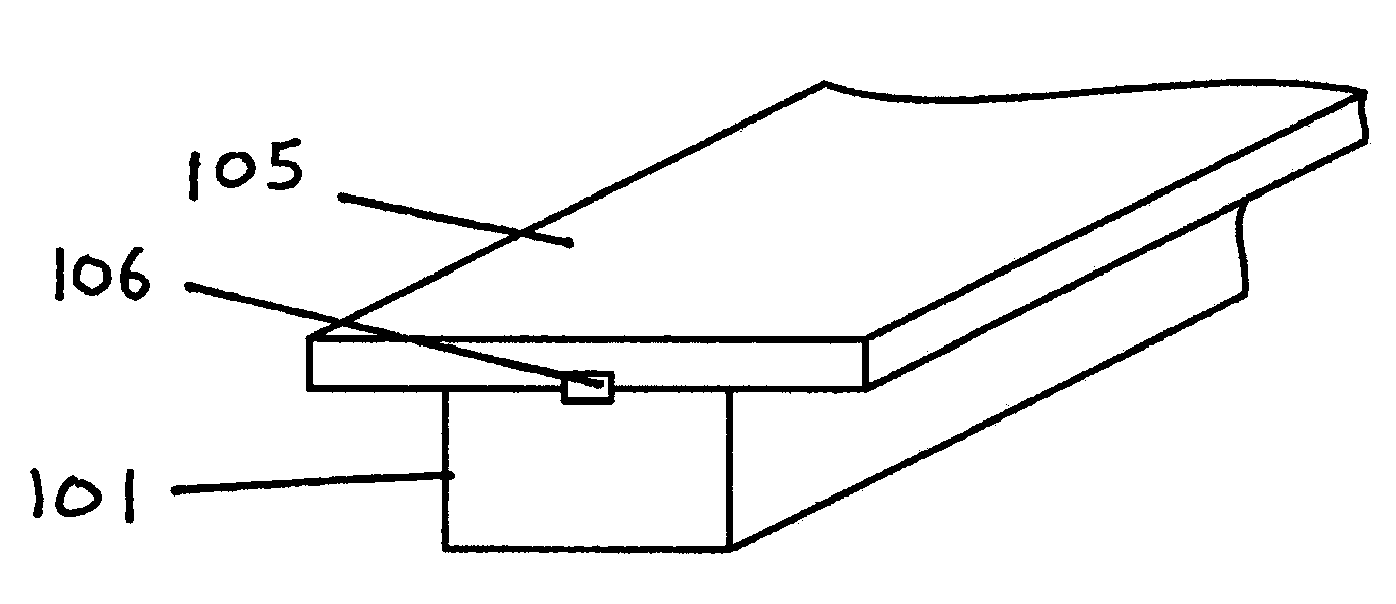Kerf cranial closure methods and device
a cranial closure and kerf technology, applied in the field of cranial closure improvements, can solve the problems of bone flap healing, never healing, palpable gap in the bone, etc., and achieve the effects of promoting bone growth and ingrowth, promoting osteogenesis and osteoinduction, and increasing the density of the strip
- Summary
- Abstract
- Description
- Claims
- Application Information
AI Technical Summary
Benefits of technology
Problems solved by technology
Method used
Image
Examples
example 1
[0065]Kerf Cranial Closure Device Design Variations when Used in Strips
[0066]The kerf cranial closure device contemplated will feature many of the following properties which may optimize cranial closure performance.
[0067]1) The design is intended to specifically close the bony defect made in the skull by any the of the common commercially available craniotomes, known as the kerf;
[0068]2) It should compress into a kerf defect;
[0069]3) The bottom side should be narrower or less dense than the top side to ease its introduction into the kerf;
[0070]4) The bottom side in its uncompressed dimensions should be slightly greater than, equal to, or less than the width of the kerf to allow it to be introduced easily into the defect to be filled;
[0071]5) It should be of a compressed width of 1-4.5 mm at the top side, 1-4 mm on the bottom side;
[0072]6) The shape is tapered with a cross-section that is wedge-shaped, trapezoidal, keel, or bullet-shaped, with the narrower end positioned towards the ...
example 2
[0082]The kerf cranial closure device contemplated may feature a bur hole plug with many of the following properties which may optimize cranial closure performance.
[0083]1) The design of the device is intended specifically to close the bony defect made in the skull, known as a bur hole (whether round, rectangular, or square), by any of the common commercially available craniotomy drills or craniotome perforators,
[0084]2) The device should compress into the bur hole defect;
[0085]4) The bottom diameter should be smaller or less dense than the top side to ease its introduction into the bur hole;
[0086]5) The bottom side in its uncompressed dimensions should be slightly more than, equal to, or less than the diameter of the bur hole to allow it to be introduced easily into the defect to be filled;
[0087]6) The device should be of a compressed width of diameter of about 10-16 mm at the top side, and 8-15.5 mm on the bottom side;
[0088]7) The shape is tapered with a cross-section that is wedg...
example 3
[0094]Exemplary Method of Using a Cranial Closure Device Such as the CranioFuse™ Cranial Closure Device.
Cranial Defect
[0095]In the creation of a craniotomy, the bone is opened from its external surface to the level of the dura by placement of one or more bur holes, made either freehand with a high-speed drill or with a cranial perforator. The bur holes are connected with a high speed drill router (craniotome footplate attachment), which creates a trough in the bone, known as the kerf.
Closure of Cranium
[0096]At the conclusion of the intracranial part of the operation, the free bone flap is secured to the surrounding cranium with a fixation device. Typically this consists of titanium plates and screws (various manufacturers, e.g. Medtronic, Integra, Codman, Innovasis, Aesculap, W. Lorenz, etc. . . . ) or a disk / post device (Rapid Flap, CranioFix, others).
Application of CranioFuse™ Cranial Closure Device
[0097]The kerf is filled with a sufficient number of CranioFuse™ Cranial Closure De...
PUM
 Login to View More
Login to View More Abstract
Description
Claims
Application Information
 Login to View More
Login to View More - R&D
- Intellectual Property
- Life Sciences
- Materials
- Tech Scout
- Unparalleled Data Quality
- Higher Quality Content
- 60% Fewer Hallucinations
Browse by: Latest US Patents, China's latest patents, Technical Efficacy Thesaurus, Application Domain, Technology Topic, Popular Technical Reports.
© 2025 PatSnap. All rights reserved.Legal|Privacy policy|Modern Slavery Act Transparency Statement|Sitemap|About US| Contact US: help@patsnap.com



